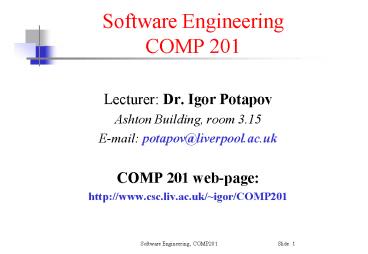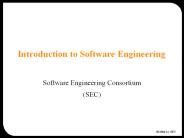Software Engineering COMP 201 - PowerPoint PPT Presentation
Title:
Software Engineering COMP 201
Description:
Teaching method Series of 30-33 lectures ... Lecture Monday 12.00 Lecture Tuesday 12.00 Lecture Thursday 14.00 ... Modelling with UML Weeks 8-10 It is ... – PowerPoint PPT presentation
Number of Views:226
Avg rating:3.0/5.0
Title: Software Engineering COMP 201
1
Software EngineeringCOMP 201
- Lecturer Dr. Igor Potapov
- Ashton Building, room 3.15
- E-mail potapov_at_liverpool.ac.uk
- COMP 201 web-page
- http//www.csc.liv.ac.uk/igor/COMP201
2
Today at 2pmComputer Science Department Lab 1
- You need to re-register your account to use our
computer science laboratories
3
Why Software Engineering?
- Software development is hard !
- Important to distinguish easy systems (one
developer, one user, experimental use only) from
hard systems (multiple developers, multiple
users, products) - Experience with easy systems is misleading
- One person techniques do not scale up
- Analogy with bridge building
- Over a stream easy, one person job
- Over River Severn ? (the techniques do
not scale)
4
Why Software Engineering ?
- The problem is complexity
- Many sources, but size is key
- UNIX contains 4 million lines of code
- Windows 2000 contains 108 lines of code
- Software engineering is about managing this
complexity.
5
Teaching method
- Series of 30-33 lectures ( 3hrs per week )
- Lecture Monday 12.00
- Lecture Tuesday 12.00
- Lecture Thursday 14.00
- Independent Student Reading
- Practical work (2 Assignments)
- ----------------------- Course Assessment
---------------------- - A two-hour examination 80
- Coursework 20
- --------------------------------------------------
---------------------
6
201 Practicals
- Practical slots
- Tuesday, 9.00-11.00 60 students
- Tuesday, 14.00-16.00 60 students
- COMP 201
- Assignment 1 Formal specification methods
- Weeks 4-7
- Assignment 2 Modelling with UML
- Weeks 8-10
- It is time consuming, so one day approach will
not work!
7
Recommended Course Textbooks
- Sommerville I. (2001,2004)
- Software Engineering 6th ,7th or 8th Edition,
Addison-Wesley, Harlow, Essex,UK - Stevens P. with Pooley, R. (2000)
- Using UML Software Engineering with Objects and
Components, - Addison-Wesley, Harlow, Essex, UK
- Introducing Asml (2001) Available in electronic
format, Microsoft corporation ?
8
Outline Syllabus
- Introduction to Software Engineering
- Software models
- Software requirements
- Formal Specification
- ASML(Abstract State Machines Language)
- Software Design and Implementation
- UML (Unified Modeling Language)
- Software verification, validation and testing
- Management of Software Projects Cost Estimation
9
FAQs about software engineering
- What is
- software?
- software process?
- software engineering?
- software process model?
10
What is software?
- Computer programs and associated documentation
- Software products may be developed for a
particular customer or may be developed for a
general market - Software products may be
- Generic - developed to be sold to a range of
different customers - Bespoke (custom) - developed for a single
customer according to their specification
11
What is software engineering?
- Software engineering is an engineering discipline
which is concerned with all aspects of software
production - Software engineers should
- adopt a systematic and organised approach to
their work - use appropriate tools and techniques depending on
- the problem to be solved,
- the development constraints and
- the resources available
12
What is the difference between software
engineering and computer science?
Computer Science
Software Engineering
is concerned with
Computer science theories are currently
insufficient to act as a complete underpinning
for software engineering, BUT it is a foundation
for practical aspects of software engineering
13
Software Engineering Body of Knowledge
Source http//www.sei.cmu.edu/pub/documents/99.re
ports/pdf/99tr004.pdf
14
SE history
- SE introduced first in 1968 conference about
software crisis when the introduction of third
generation computer hardware led more complex
software systems then before - Early approaches based on informal methodologies
leading to - Delays in software delivery
- Higher costs than initially estimated
- Unreliable, difficult to maintain software
- Need for new methods and techniques to manage the
production of complex software.
15
Software myths
- Management myths
- Standards and procedures for building software
- Add more programmers if behind the schedule
- Customer myths
- A general description of objectives enough to
start coding - Requirements may change as the software is
flexible - Practitioner myths
- Task accomplished when the program works
- Quality assessment when the program is running
- Working program the only project deliverable
16
Software failures
- Therac-25 (1985-1987) six people overexposed
during treatments for cancer - Taurus (1993) the planned automatic transaction
settlement system for London Stock Exchange
cancelled after five years of development - Ariane 5 (1996) roket exploded soon after its
launch due error conversion (16 floating point
into 16-bit integer) - The Mars Climate Orbiter assumed to be lost by
NASA officials (1999) different measurement
systems (Imperial and metric)
17
However
- Important progress
- Ability to produce more complex software has
increased - New technologies have led to new SE approaches
- A better understanding of the activities involved
in software development - Effective methods to specify, design and
implement software have been developed - New notations and tools have been produced
18
What is a software process?
- SP is a set of activities whose goal is the
development or evolution of software - Fundamental activities in all software processes
are - Specification - what the system should do
- and its development constraints
- Development - production of the software system
- (design and implementation)
- Validation - checking that the software is what
the customer wants - Evolution - changing the software in response to
changing demands
19
What is a software process model?
- SPM is a simplified representation of a software
process, presented from a specific perspective - Examples of process perspectives
- Workflow perspective represents inputs, outputs
and dependencies - Data-flow perspective represents data
transformation activities - Role/action perspective represents the
roles/activities of the people
involved in software process - Generic process models
- Waterfall
- Evolutionary development
- Formal transformation
- Integration from reusable components
20
What are the costs of software engineering?
- Roughly 60 of costs are development costs,
40 are testing costs. For custom software,
evolution costs often exceed development costs - Costs vary depending on the type of system being
developed and the requirements of system
attributes such as performance and system
reliability - Distribution of costs depends on the development
model that is used
21
What is CASE ? (Computer-Aided Software
Engineering)
Software systems which are intended to provide
automated support for software process
activities, such as requirements analysis, system
modelling, debugging and testing
- Upper-CASE
- Tools to support the early process activities
of requirements and design - Lower-CASE
- Tools to support later activities such as
programming, debugging and testing
22
What are the attributes of good software?
The software should deliver the required
functionality and performance to the user and
should be maintainable, dependable and usable
- Maintainability
- Software must evolve to meet changing needs
- Dependability
- Software must be trustworthy
- Efficiency
- Software should not make wasteful use of system
resources - Usability
- Software must be usable by the users for which it
was designed
23
What are the key challenges facing software
engineering?
- Software engineering in the 21st century faces
three key challenges - Legacy systems
- Old, valuable systems must be maintained and
updated - Heterogeneity
- Systems are distributed and include a mix of
hardware and software - Delivery
- There is increasing pressure
- for faster delivery of software
24
Next lecture
- Software Processes
- Tuesday 12.00
- COMP 201 web-page
- http//www.csc.liv.ac.uk/igor/COMP201































